

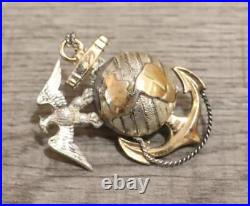


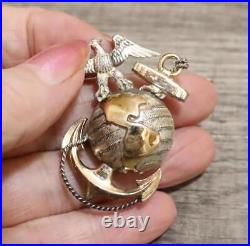




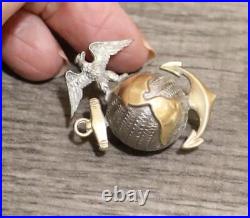

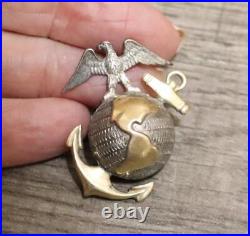










PICTURES Our pictures are cropped to show the largest image. Therefore, some pictures will appear larger or smaller than they are. Some pictures are lighter to show a brighter view and make it easier to see the image. PLEASE CLOSELY LOOK AT ALL OF THE PICTURES BECAUSE THEY ARE PART OF THE DESCRIPTION. PLEASE SEE THE ITEM SPECIFICS BELOW. THE ITEM YOU SEE IS THE ITEM YOU WILL RECEIVE UNLESS I HAVE MORE THAN ONE, THEN YOU WILL RECEIVE A SIMILAR ITEM TO THE PICTURE. 1930s USMC PATTERN 1927 OFFICER’S DRESS BLUES H-H PAIR COLLAR SCREWS & HAT BADGE. The hat screw badge is marked with the hallmark H-H, and the back is also marked 1/20 Silver, Sterling. The pair of collar screws are marked 10K, sterling and H-H. A total of 3 USMC insignias. This is from 1927 through 1936. The rope is not wrapped around the anchor but in an arch design, which is the 1927 pattern. Also, the 1927 Hilborn Hamburger pattern has the legs spread apart. Hilborn Hamburger continued to use this pattern after 1937. The most desirable pattern is the legs spread apart. Please review the pictures carefully, as they are also part of the description. My passion is history, and I desire that my vintage militaria items go to collectors so that our past lives on and the items will continue to be preserved. Many many years ago, a collector friend of mine came over to see my collection. He said to me, you do not own these items; they are simply on loan to you until another collector buys your items to enjoy and preserve. Years later, I realized just how exact his words were. It is important to me that vintage items are preserved for years to come for history. This item has been in my collection for many years. My collections are in rooms that do not get any outside light. Therefore, you won’t find any fading with my militaria items in a smoke-free environment. No cats and only a little Yorkie occasionally. We sincerely appreciate the thousands of eBayers. With whom we have enjoyed doing business. Our pictures are cropped to show the largest image. PLEASE LOOK AT THE. ITEM YOU SEE IS THE ITEM YOU WILL RECEIVE. UNLESS I HAVE MORE THAN ONE, THEN YOU WILL RECEIVE A SIMILAR ITEM TO THE PICTURE. Many years ago, a collector friend came over to see my collection. He said, You do not own these items; they are simply on loan until another collector buys your items to enjoy and preserve. Cats and only a little Yorkie occasionally. Get Supersized Images & Free Image Hosting. Create your brand with Auctiva’s. Attention Sellers – Get Templates Image Hosting, Scheduling at Auctiva. Com.





PLEASE FOLLOW OUR E BAY STORE. SALE SEE OUR STORE. PLEASE READ WHOLE ADD. Japanese Commemorative Medal of 1937 Incident Marco Polo Bridge 55 mm Diameter. Offering a Japanese commemorative medal. The medal was issued by Japan commemorating the July 7 1937 incident at the Marco Polo Bridge. The incident resulted in the Second Sino-Chinese War. Check out the photos. Marco Polo Bridge incident. Part of the Second Sino-Japanese War. Aerial photo of the Marco Polo Bridge. Is on the opposite side of the river. Start of the Second Sino-Japanese War. Disputed starting date of World War II. 100 troops at the bridge. Military campaigns of the. The Marco Polo Bridge incident, also known as the Lugou Bridge incident. Or the July 7 incident. Was a battle during July 1937 in the district of Beijing between China. S National Revolutionary Army. And the Imperial Japanese Army. Since the Japanese invasion of Manchuria. In 1931, there had been many small incidents along the rail line connecting Beijing. With the port of Tianjin. But all had subsided. In this incident, a Japanese soldier was temporarily absent from his unit opposite Wanping. And his commander demanded the right to search the town for him. The Marco Polo Bridge incident is generally regarded as the start of the Second Sino-Japanese War. And the Pacific theatre. Of World War II. In English, the battle is usually known as the “Marco Polo Bridge incident”. The Marco Polo Bridge. Is an eleven-arch granite bridge, an architecturally significant structure first erected under the Jin dynasty. And later restored during the reign of the Kangxi Emperor. Of the Qing dynasty. It gained its Western name from its appearance in Marco Polo. S record of his travels. It is also known as the “Lukouchiao”. From the local name of the bridge, derived from a former name of the Yongding River. This is the common name for the event in Japanese. Rokokyo Jiken and is an alternate name for it in Chinese and Korean. The same name is also expressed or translated as the. Battle of Lugou Bridge. In China and Korea, it is known more often as the. Tensions between the Empire of Japan. And the Republic of China. Had been heightened since the Japanese invasion of Manchuria. In 1931 and their subsequent creation of a client state, Manchukuo. The deposed Qing dynasty. Emperor, as its chief of state. After the invasion, Japanese forces extended their control further into northern China, seeking to obtain raw materials and industrial capacity. A commission of inquiry from the League of Nations. Published the Lytton Report. Which was critical of the Japanese, resulting in Japan quitting the League. (KMT) government of China refused to recognize Manchukuo but did agree to the Tanggu Truce. With Japan in 1933. Subsequently, there were various “incidents”, or armed clashes of a limited nature, followed by a return to uneasy peace. The significance of the Marco Polo Bridge incident is that, following it, tensions did not subside again; instead, there was an escalation, with larger forces committed by both sides and fighting spreading to other parts of China. With hindsight, this small incident can, therefore, be regarded as the start of a major conflict. By the terms of the Boxer Protocol. Of 7 September 1901, China had granted nations with legations in Beijing. The right to station guards at twelve specific points along railways connecting Beijing with Tianjin. This was to ensure open communications between the capital and the port. By a supplementary agreement on 15 July 1902, these forces were allowed to conduct maneuvers without informing the authorities of other nations in China. Allied Commander-in-Chief in the China theater from 1942 to 1945. By July 1937, Japan had expanded its forces in China to an estimated 7,000 to 15,000 men, mostly along the railways. This number of men, and the amount of concomitant matériel, was several times the size of the detachments deployed by the European powers, and greatly in excess of the limits set by the Boxer Protocol. By this time, the Imperial Japanese Army. Had already surrounded Beijing. On the night of 7 July, the Japanese units stationed at Fengtai. Crossed the border to conduct military exercises. Japanese and Chinese forces outside the town of Wanping. A walled town 16.4 km (10.2 mi) southwest of Beijing-exchanged fire at approximately 23:00. The exact cause of this incident remains unknown. When a Japanese soldier, Private Shimura Kikujiro, failed to return to his post, Chinese regimental commander Ji Xingwen. (219th Regiment, 37th Division, 29th Army) received a message from the Japanese demanding permission to enter Wanping to search for the missing soldier; the Chinese refused. , by this time both sides were mobilizing, with the Japanese deploying reinforcements to surround Wanping. Later that night, a unit of Japanese infantry attempted to breach Wanping’s walled defenses but were repulsed. An ultimatum by the Japanese was issued two hours later. As a precautionary measure, Qin Dechun. The acting commander of the Chinese 29th Route Army, contacted the commander of the Chinese 37th Division, General Feng Zhian. Ordering him to place his troops on heightened alert. Japanese forces bombarding Wanping Fortress. At 02:00 on 8 July, Qin Dechun. Executive officer and acting commander of the Chinese 29th Route Army, sent Wang Lengzhai, mayor of Wanping. Alone to the Japanese camp to conduct negotiations. However, this proved to be fruitless, and the Japanese insisted that they be admitted into the town to investigate the cause of the incident. At around 04:00, reinforcements of both sides began to arrive. The Chinese also rushed an extra division of troops to the area. Within five minutes of Wang’s return, a shot was heard, and both sides began firing. Thus marking the commencement of the Battle of Beiping-Tianjin. And, by extension, the full scale commencement of the Second Sino-Japanese War. At 04:50 on 8 July 1937. Led the Chinese defenses with about 100 men, with orders to hold the bridge at all costs. The Chinese were able to hold the bridge with the help of reinforcements, but suffered tremendous losses. At this point, the Japanese military and members of the Japanese Foreign Service began negotiations in Beijing with the Chinese Nationalist government. A verbal agreement with Chinese General Qin was reached, whereby. An apology would be given by the Chinese to the Japanese. Punishment would be dealt to those responsible. Control of Wanping would be turned over to the Hopei. And not to the Chinese 219th Regiment. The Chinese would attempt to better control “communists” in the area. This was agreed upon, though Japanese Garrison Infantry Brigade commander General Masakazu Kawabe. Initially rejected the truce and, against his superiors’ orders, continued to shell Wanping for the next three hours, until prevailed upon to cease and to move his forces to the northeast. Although a ceasefire had been declared, further efforts to de-escalate the conflict failed, largely due to actions by the Chinese Communists. And the Japanese China Garrison Army. Due to constant Chinese attacks, Japanese Garrison Infantry Brigade commander General Masakazu Kawabe. Ordered Wanping to be shelled on 9 July. The following day, Japanese armored units joined the attack. The Chinese 219th regiment staged an effective resistance, and full scale fighting commenced at Langfang. After launching a bitter and bloody attack on the Japanese lines on the 27 July, General Sung was defeated and forced to retreat behind the Yongding River. By the next day. Main article: Battle of Beiping-Tianjin. On 11 July, in accordance with the Goso conference, the Imperial Japanese Army General Staff. Authorized the deployment of an infantry division. From the Chosen Army. Two combined brigades from the Kwantung Army. And an air regiment composed of 18 squadrons as reinforcements to Northern China. By 20 July, total Japanese military strength in the Beiping-Tianjin area exceeded 180,000 personnel. The Japanese gave Sung and his troops “free passage” before moving in to pacify resistance in areas surrounding Beijing and Tianjin. After 24 days of combat, the Chinese 29th Army was forced to withdraw. The Japanese captured Beiping and the Taku Forts. At Tianjin on 29 and 30 July respectively, thus concluding the Beiping-Tianjin campaign. However, the Japanese Army had been given orders not to advance further than the Yongding River. In a sudden volte-face. The Konoe government’s foreign minister opened negotiations with Chiang Kai-shek. S government in Nanjing and stated: Japan wants Chinese cooperation, not Chinese land. Nevertheless, negotiations failed to move further. On 9 August 1937, a Japanese naval officer was shot in Shanghai. Escalating the skirmishes and battles into full scale warfare. The 29th Army’s resistance (and poor equipment) inspired the 1937 Sword March. , which-with slightly reworked lyrics-became the National Revolutionary Army. S standard marching cadence. And popularized the racial epithet. To describe the Japanese invaders. Damage from the Japanese shells on the wall of Wanping Fortress is marked with a memorial plaque now. The texts on the stone drums below summarizes the history of the war that followed the incident. The heightened tensions of the Marco Polo Bridge incident led directly to full-scale war between the Empire of Japan. With the Battle of Beiping-Tianjin. At the end of July and the Battle of Shanghai. In 1937, during the Battle of Beiping-Tianjin. The government was notified by Muslim General Ma Bufang. Of the Ma clique. That he was prepared to bring the fight to the Japanese in a telegram message. Immediately after the Marco Polo Bridge incident, Ma Bufang arranged for a cavalry division under the Muslim General Ma Biao. To be sent east to battle the Japanese. Ethnic Turkic Salar Muslims. Made up the majority of the first cavalry division which was sent by Ma Bufang. 7 July 1937 is sometimes given as an alternative starting date for World War II. As opposed to the more commonly-cited date of 1 September 1939, when Germany invaded Poland. Starting the European theatre of the war. In 1987, the bridge was renovated and the People’s Anti-Japanese War Museum. Was built near the bridge to commemorate the anniversary of the start of the Sino-Japanese War. There is debate over whether the incident could have been planned like the earlier Mukden incident. Which served as a pretext for the Japanese invasion of Manchuria. According to Jim Huffman this notion has been “widely rejected” by historians, as the Japanese would likely have been more concerned over the threat posed by the Soviets. Controversial conservative Japanese historian Ikuhiko Hata. Has suggested that the incident could have been caused by the Chinese Communist Party. Hoping it would lead to a war of attrition. Between the Japanese army and the Kuomintang. However, he himself still considers this less likely than the “accidental shot” hypothesis, that the first shot was fired by a low-ranking Chinese soldier in “an unplanned moment of fear”. National Revolutionary Army (Kuomintang). See also: National Revolutionary Army. In comparison to their Japanese counterparts, the 29th Route Army, and generally all of the NRA for that matter, was poorly equipped and under-trained. Most soldiers were armed only with a rifle and a dao. A single-edged Chinese sword. Similar to a machete. Moreover, the Chinese garrison in the Lugouqiao area was completely outnumbered and outgunned; it consisted only of about 100 soldiers. Commander of 29th Army. Legislative Committee Head of Peking security forces. Vice-Commander of 29th Army. General Tong Lin’ge. Commander of the 143rd Division. General Feng Zhi’an. Commander of the 37th Division. Commander of the 132nd Division. Commander of the 38th Division. Commander of the 219th Regiment under the 110th Brigade of the 37th Division. The Japanese China Garrison Army. Was a combined force of infantry, tanks. Which had been stationed in China since the time of the Boxer Rebellion. Its headquarters and bulk for its forces were in Tianjin, with a major detachment in Beijing to protect the Japanese embassy. Lieutenant General Kan’ichiro Tashiro. Commander China Garrison Army. Major General Masakazu Kawabe. Commander China Garrison Infantry Brigade. Commander 1st Infantry Regiment. Commander, 3rd Battalion, 1st Infantry Regiment. W of Marco Polo Bridge, 510 men.










PICTURES Our pictures are cropped to show the largest image. Therefore, some pictures will appear larger or smaller than they are. Some pictures are lighter to show a brighter view and make it easier to see the image. PLEASE CLOSELY LOOK AT ALL OF THE PICTURES BECAUSE THEY ARE PART OF THE DESCRIPTION. PLEASE SEE THE ITEM SPECIFICS BELOW. THE ITEM YOU SEE IS THE ITEM YOU WILL RECEIVE UNLESS I HAVE MORE THAN ONE, THEN YOU WILL RECEIVE A SIMILAR ITEM TO THE PICTURE. 1930’s USMC PATTERN 1927 OFFICER’S DRESS BLUES H-H 1/20 STERLING SILVER HAT BADGE. This hat device is marked with the hallmark H-H, and the back is also marked 1/20 Silver, Sterling. This is from 1927 through 1936. The rope is not wrapped around the anchor but in an arch design, which is the 1927 pattern. Also, the 1927 Hilborn Hamburger pattern has the legs spread apart. Hilborn Hamburger continued to use this pattern after 1937. The most desirable pattern is the legs spread apart. Please review the pictures carefully, as they are also part of the description. My passion is history, and I desire that my vintage militaria items go to collectors so that our past lives on and the items will continue to be preserved. Many many years ago, a collector friend of mine came over to see my collection. He said to me, you do not own these items; they are simply on loan to you until another collector buys your items to enjoy and preserve. Years later, I realized just how exact his words were. It is important to me that vintage items are preserved for years to come for history. This item has been in my collection for many years. My collections are in rooms that do not get any outside light. Therefore, you won’t find any fading with my militaria items in a smoke-free environment. No cats and only a little Yorkie occasionally. 1930 USMC PATTERN 1927 OFFICER’S DRESS BLUES H-H 1/20 STERLING SILVER HAT BADGE. We sincerely appreciate the thousands of eBayers. With whom we have enjoyed doing business. Our pictures are cropped to show the largest image. PLEASE LOOK AT THE. ITEM YOU SEE IS THE ITEM YOU WILL RECEIVE. UNLESS I HAVE MORE THAN ONE, THEN YOU WILL RECEIVE A SIMILAR ITEM TO THE PICTURE. Many years ago, a collector friend came over to see my collection. He said, You do not own these items; they are simply on loan until another collector buys your items to enjoy and preserve. Cats and only a little Yorkie occasionally. Auctiva offers Free Image Hosting and Editing. Auctiva gets you noticed!


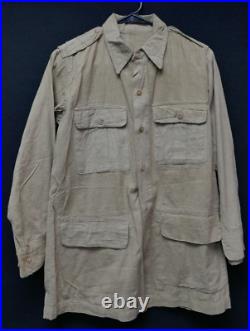
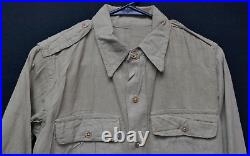
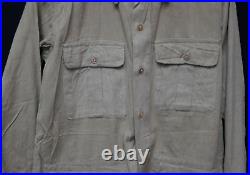

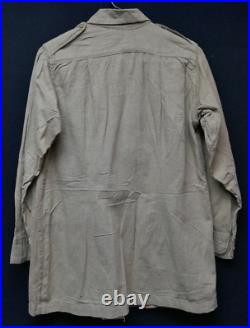




1930’s South Pacific Tropical Linen Bush Coat Jungle Jacket Button Type, Light. Original 1930’s South Pacific Tropical Linen Bush Coat Jungle Jacket Button Type, Light. As Photographed with wear as seen. A Nice Candidate for any Period Collection, Impression, or Display. Recent Estate Collection Acquisition & Presented as Acquired. Check back often – we search estates and sources across the world to bring a fine selection of militaria. Please review all photos for details regarding the condition of the item listed – further condition information will be included in the listing as is relevant, if you need additional photographs or have questions regarding the condition please do not hesitate to ask. I describe all items to the best of my ability – please do not hesitate to ask any and all questions prior to the close of the listing. Mistakes very rarely occur – however if one does please rest assured that it will be corrected. International Buyers are Welcome!




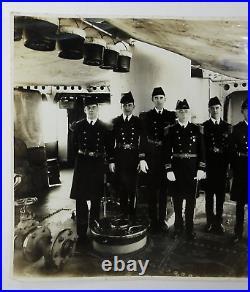







Estate sale find, vintage original US Navy China Service Destroyer USS Rizal Officers photo, circa 1920s. Photo is embossed in lower right corner with A. Fong Chefoo, North China. USS Rizal (DD–174) was a Wickes-class destroyer in the United States Navy following World War I. She was named for José Rizal, a Filipino patriot, and the National Hero of the Philippines. Joining the Pacific Fleet upon commissioning, Rizal cruised along the United States west coast into 1920 on exercises and training duty. Subsequently modified for service as a light minelayer, she was classified DM-14 on 17 July 1920. Rizal departed San Diego on 25 March 1920 for the Far East. With Filipinos constituting the majority of her crew, Rizal remained on the Asiatic Station for ten years. She spent long months anchored in Chinese ports during the spring, summer, and autumn months. Her most frequent ports of call were Shanghai, Chefoo, Chinwangtao, and Hong Kong. Rizal cruised eastward to Apra Harbor, Guam, during November 1928, and visited Yokohama, Japan, from 11 to 20 April 1929. Rizal spent each winter generally from November through March, anchored in Manila Bay. She was docked annually at Olongapo and upon resuming active service each spring operated in Philippine waters. Ordered home late in 1930, Rizal departed Manila on 11 December 1930 for Guam, Honolulu, and San Diego. She decommissioned on 20 August 1931 at San Diego and was towed northward to Mare Island on 31 August 1931 by the minesweeper USS Tern to be placed in reserve. PLEASE SEE DESCRIPTION AND PHOTOS FOR ADDITIONAL DETAILS – The item appears to be in overall Fair to Good Minus used condition, signs of wear, creases, fading, tears, chipping, sunning and age toning, soiling, stains, writing, no odors, please see images.










1931 Particulars w/Regard to The Armaments of the United States Dept. Neat book teaching courses by US Army. Please Check Out All My Other Auctions For Sale Right Now! IF YOU MUST RETURN PLEASE CONTACT ME PRIOR TO FILING A CLAIM. WE CAN WORK IT OUT. Collecting Cards for over 50 Years our inventory is quite extensive. Lots of Stunning Cards for Sale. Card Grading Note: Typical Note on Card Grading. High Grade = Mint, Near Mint, EXMT-NM PSA 7-10. Mid Grade = EXMT, EX, VGEX PSA 4-6. Low Grade = VG, Fair, Poor PSA 1-3. SEND ME A LINE AND WE CAN DISCUSS YOUR COLLECTIONS. THE BEST IS RIGHT HERE. If you decide to return, please send it back to us in the same condition as it was sent. We do our best to describe all items and provide as much knowledge about the item as we can, but we are not experts in all fields. If you are not happy with your item due to description discrepancies, please ask questions first before filing a Return Claim. Let us see if an arrangement can be worked out to both our satisfactions. We here at Chubby Cat Collectibles and Vintage Sports Memorabilia are a very small outfit and value your business. We offer a eclectic mix of items but specialize in Vintage Sports Memorabilia and War & Strategy Games. In order to keep our stock fresh, we scour the Wild West in search of super neat, unique and curiosities. Our goal is to make you happy by providing the opportunity to obtain True Treasures and Collectibles. If you like Vintage Sports Memorabilia, We got’em. If you like War Games, we got’em. If you like Old Toys, we got’em. And the Big Question we get many times is if we really have a Chubby Cat? Yes we got one. CHUBBY CAT SPORTS MEMORABILIA & COLLECTIBLES. We always welcome comments and questions.





October 31, 1929 Goodyear Zeppelin souvenir from the ZRS-4 ring laying ceremony in Akron Ohio. Excellent condition (see pics).


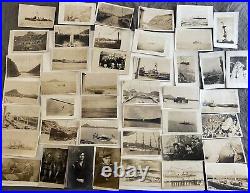



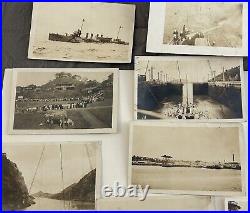
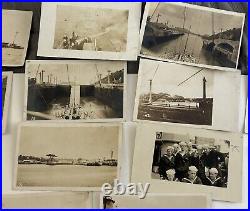





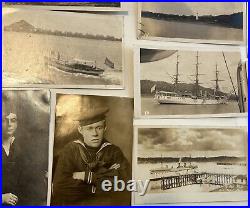




Very clear there is some wear so check the photos. They are part of the description and show condition.









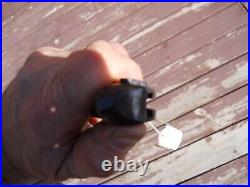


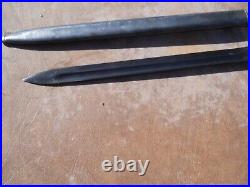



One original and very rare Mexican model 1936 mauser short rifle bayonet with matching serial numbered scabbard bayonet and scabbard are in very good to excellent condition, bayonet has factory edge and blue/black finish handles are very good, release works smoothly, serial numbered 15222 near the release, scabbard has factory blue/black finish, ding free, serial numbered 15222 on frog stud. Also fits the mexican, spanish and chilean model 1895 mauser short rifles and carbines, bayonet is for the 7mm mauser caliber mexican model 1936 short rifle, see my other listings for more Mexican model 1936 mauser short rifle parts and accessories.



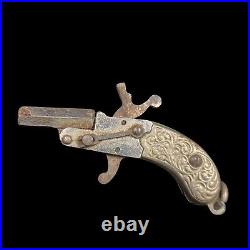
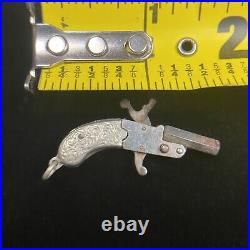







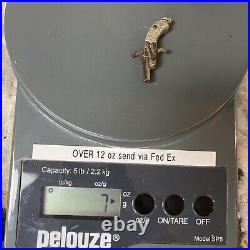

Barrel-breaks open appears to function mechanically see photos for more details.











































































































